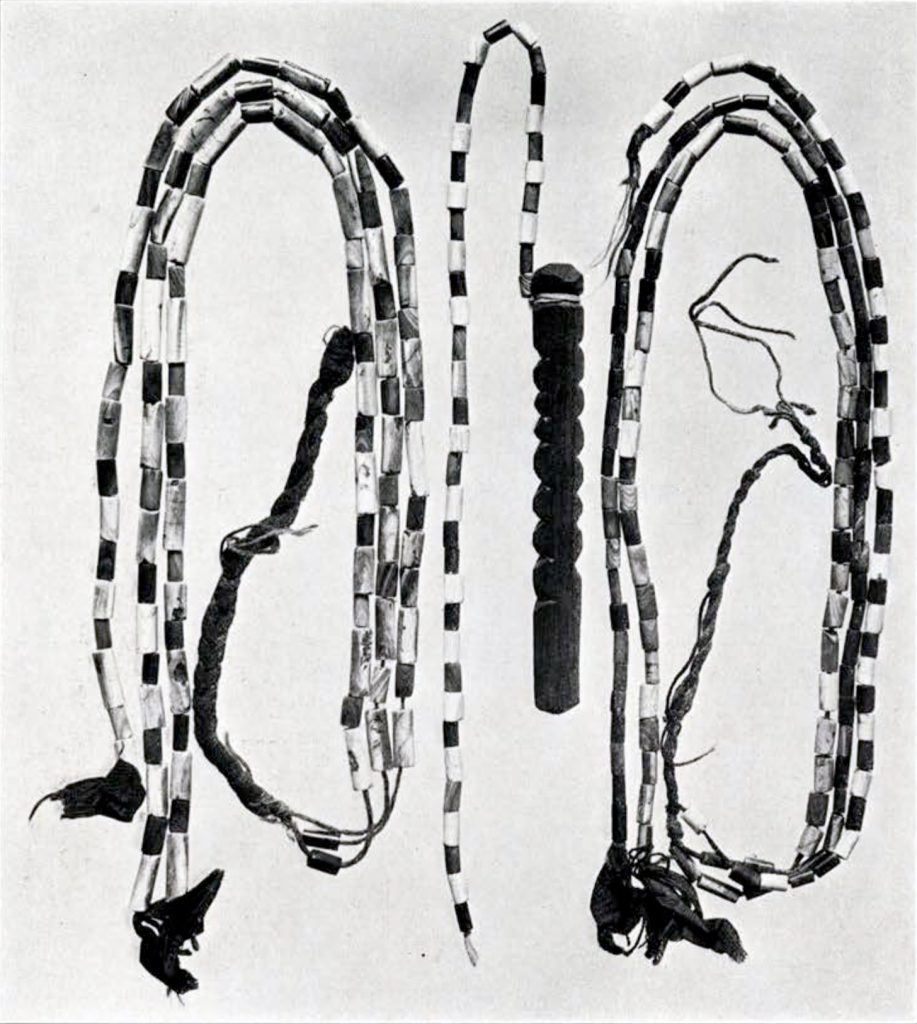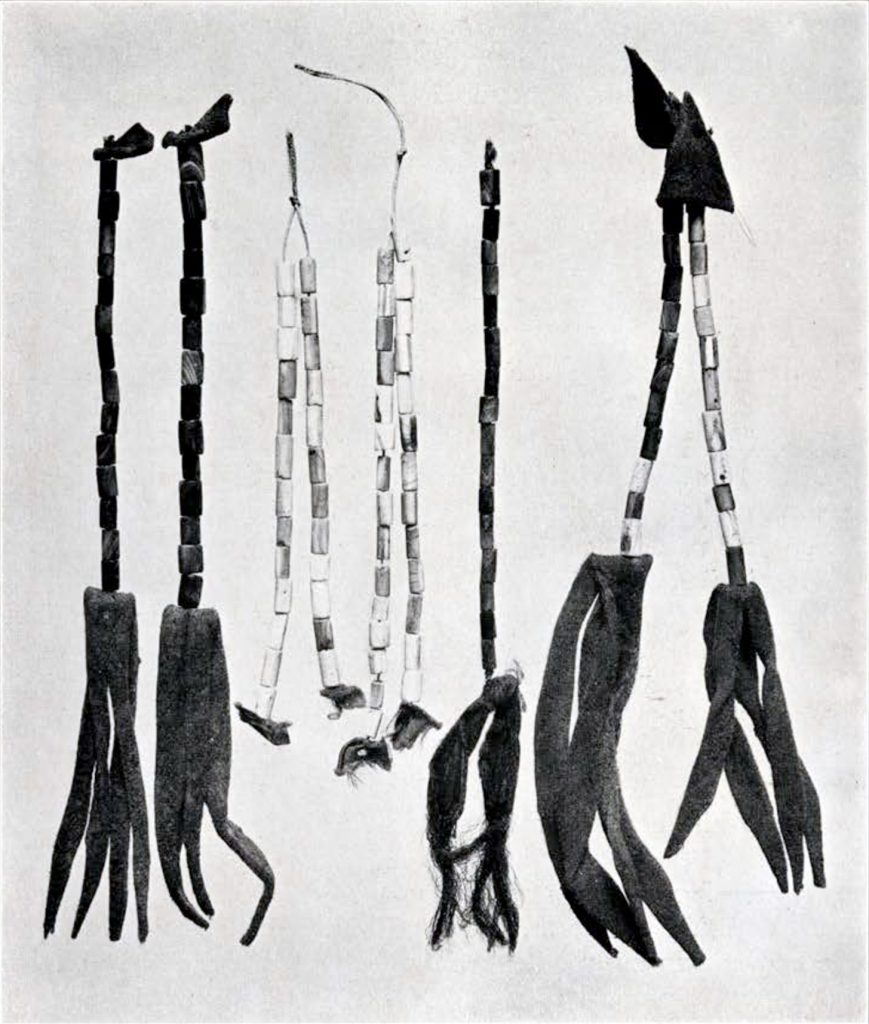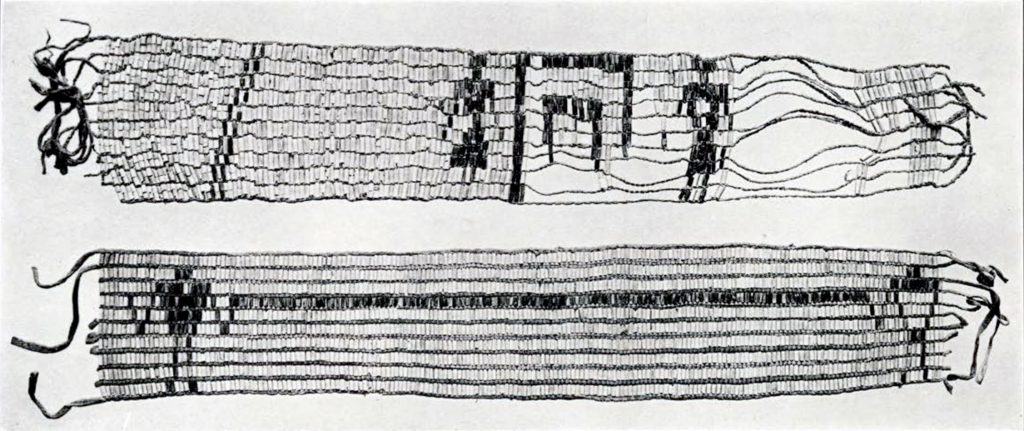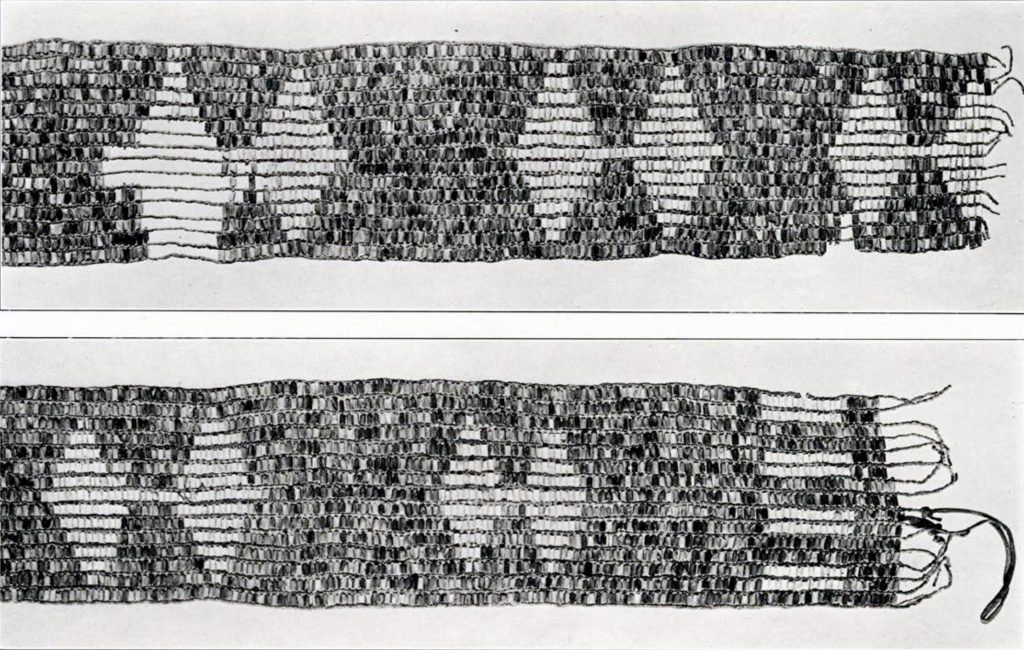In studying the culture of the American Indians one is surprised at the many ingenious devices used. Many of the North American tribes used picture writing and some had devised still other methods. The ancient Peruvians used the quipu, on which associated things were recorded by means of knots in different colored strings. A system somewhat similar to this had also been developed among the Iroquois and their neighbors living in the eastern part of the United States. In this system wampum in the form of belts, necklaces or strings was used. The belts were used for recording the more important things, such as treaties, declarations of war or peace, and long journeys. The strings, used as single strands or as a bunch of strands, served for lesser things, such as passports or name of an office, records of laws, and invitations or announcements.
Among the many specimens of wampum in the George G. Heye Collection is one consisting of a small notched stick to which are attached two short strings of white wampum. One string has a single purple bead and both of them have pieces of blue ribbon at their ends. This was carried to the different bands or villages and served as an invitation to the Annual Green Corn Festival. The number of notches on the stick told how many days until the celebration. A similar notched stick having a strand of purple beads ending in a piece of white cloth served as a notice of a meeting of the Tribal Councillors.

Image Number: 12960
At a meeting of these councillors, if it were found necessary to reduce and expel a member for some violation of their law, a bunch of three strands of wampum (Fig. 155 c) was used as the basis of the ceremony of abrogation. First the short strand of alternating white and purple beads was held by some chief who accused the culprit and urged him to reform, or “step back into the path.” If this appeal were unsuccessful the long strand mostly of white beads was exposed while a deputation of chiefs urged their brother “to step back into the path.” In case this failed the clan elders of the woman clan, called the clan mothers, took the case and while exposing the third string warned the offender and urged him to repent. This was the final chance for the wrongdoer and if he neglected to take it he was reduced from the rank of chief and his name and office were given to another. As a sign that the chief had been reduced a purple strand containing two white beads was held while some leader announced that it signified total annulment and entire severance of membership. Others of the chiefs held short purple (Fig. 156 a) strands while they expressed sorrow and condolence.
In case of a chief’s death three short strings of wampum (Fig. 156 b) were carried about to notify the different bands. One of these strings, which was purple and had a piece of black cloth attached to it, served as a notice of death and mourning. The white strand, with a piece of blue cloth attached, signified that the title and office of the chief would continue, while the white strand, with green cloth, showed that the deceased’s name and office would be transferred to his successor. For notifying the chiefs two short purple strands connected by and terminating with pieces of leather were used.
Another specimen (Fig. 155 a) was used by the clan elders or clan mothers to urge husband and wife to agree and live in kindliness, if there had been a family quarrel. The green attached to one of the strands symbolizes the “life” and the importance of their mission as parents. The black attached to the other strands stands for the seriousness of the subject, while the red, which holds the strands together, emphasizes the potency of the warning given to the parents. The long white beads in this specimen are very old and are said to have always been used as in this case, that is in cases pertaining to the relationship of men and women.

Image Number: 12961
In addition to the strings of wampum with their peculiar or little known uses, are the belts and necklaces, which serve especially as the great historical records. The oldest belt in the collection was given by the Hurons to the Iroquois to confirm a treaty in 1612. A purple square in the middle of a white belt serves as the. Huron Nation, while purple and white stripes at the ends represent people and peace respectively. The belt is thus interpreted to mean that the people of the two tribes walk together in peace.
Perhaps the most interesting belt historically is the First Penn Treaty Belt (Fig. 157), which was given by William Penn to the assembled chiefs in making his famous treaty in 1682. The two men are said to represent Penn and an Indian and the diagonal white line signifies that it is the first treaty. Unfortunately this valuable belt has been broken in many places and a number of the beads lost.
Of almost equal interest is a belt (Fig. 158) carried by the great French missionary and explorer, Marquette. While there is little known about this belt or what it stands for, the four white crosses give some hint as to its meaning. Another French belt is purple with two squares and two hexagons in white. This belt was given to the Indians about 1700 to confirm an agreement by which they were to watch and guard the French forts on the coast.
A belt connected with the history of early Pennsylvania is the Gov. Denny Belt (Fig. 157) which was given to the Indians of the upper Ohio River in 1756. The belt represents Governor Denny and an Indian connected by a path when the former invites all of the Indians to come from the Ohio to Philadelphia saying, “I have laid out a nice smooth road for you and want all to come who can.”
One of the belts (Fig. 158) in the collection brings to mind the close of the Revolutionary War. It was given to the Indians by the Commission, settling the boundary in 1789, to symbolize the two governments. Two white stripes run the entire length of the belt and show that the Indians “had two roads offered to them. They could go to the British Government or to the United States.”

Image Number: 12963

Image Number: 12965
There are also some belts which were used to reveal the wishes or intentions of a tribe or some of its members. A long purple belt with five pair of connected diamonds in white was the War Belt of the Five Nations. For peace the belt was white and had five purple diamonds on it. To express sorrow or condolence a belt all of purple was used.
Many of the rich and important Indians had private belts which have found their way into the collection. Among these is the Capt. Joseph Brant Belt which refers to a. journey Brant made to England in 1775. This journey is designated on the belt by a line which connects two squares standing for England and the reservation. Other belts belonged to such chiefs as Red Jacket and Black Hawk.
A belt referring to a journey made by some western Chippewa to George III in 1807 contains the only trace of writing. The date and the initials at the ends of the belt and the pipe and two men connected by a line readily show that a peaceful journey is recorded.
In addition to many other belts and strings, there are three necklaces, which likewise refer to treaties. One of the necklaces has nine purple sections separated by white lines and commemorates a treaty made among the nine principal tribes of the St. Lawrence drainage area.
B. W. M.

